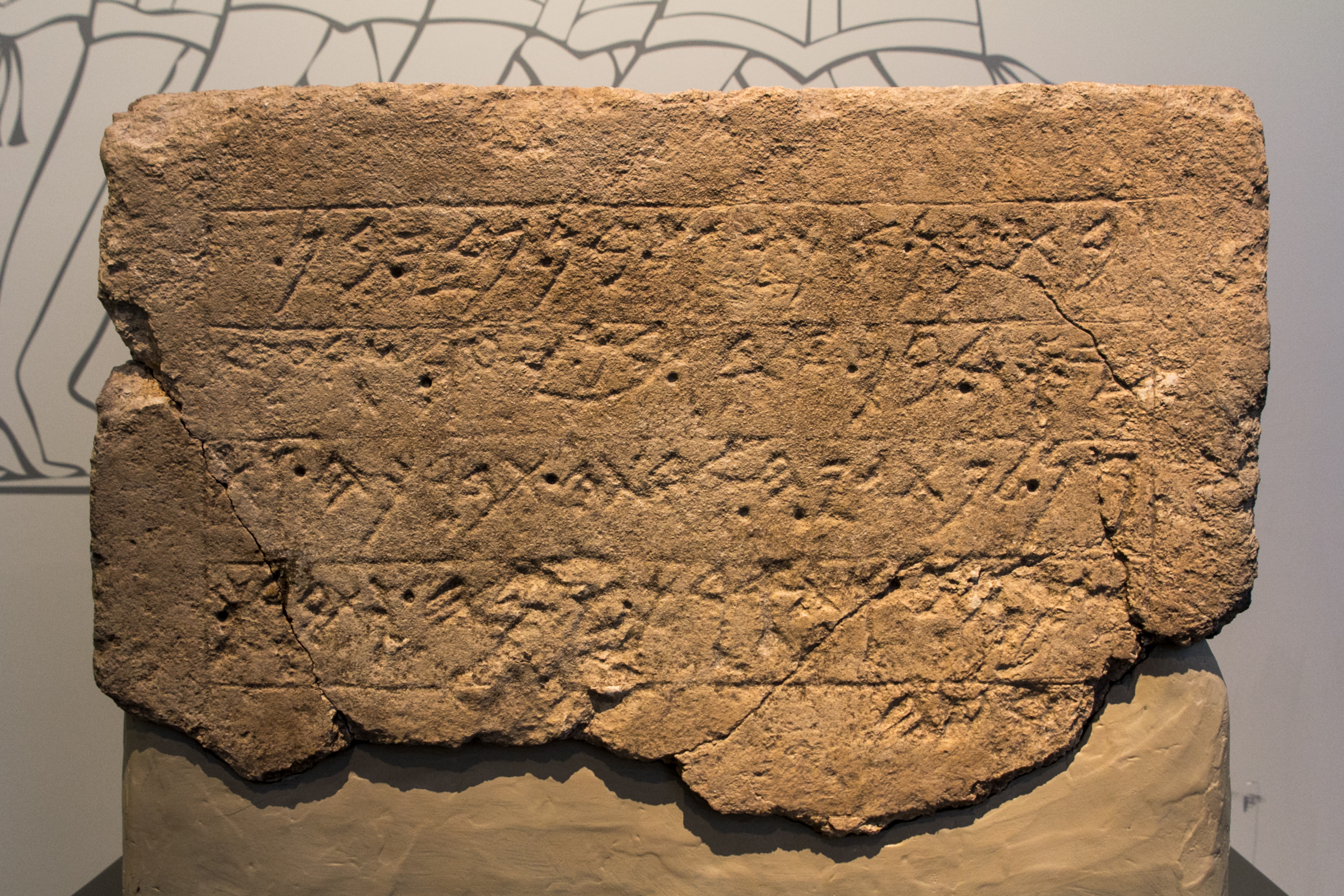|
Ekronite Language
The Ekron Royal Dedicatory Inscription, or simply the Ekron inscription, is a royal dedication inscription found in its Archaeological context, primary context, in the ruins of a temple during the 1996 excavations of Ekron, Israel.Gitin, Dothan, and Naveh, 1997, p. 1 It is known as Kanaanäische und Aramäische Inschriften, KAI 286. It is incised on a rectangular-shaped limestone block with five lines and 71 characters, and mentions Ekron, thus confirming the identification of the site, as well as five of its rulers, including Ikausu (Achish), son of Padi, who built the sanctuary. Padi and Ikausu are known as kings of Ekron from the late 8th- and 7th-century Neo-Assyrian Royal Annals.Gitin, Seymour (2003), Israelite and Philistine Cult and the Archaeological Record, in ''Symbiosis, Symbolism, and the Power of the Past'', p. 287, "Two of the five names of city's rulers mentioned in the inscription - Padi and Ikausu - appear in the Neo-Assyrian Annals as kings of ‘amqar(r)una, tha ... [...More Info...] [...Related Items...] OR: [Wikipedia] [Google] [Baidu] |
Gimel
Gimel is the third (in alphabetical order; fifth in spelling order) letter of the Semitic abjads, including Phoenician ''gīml'' 𐤂, Hebrew ''gīmel'' , Aramaic ''gāmal'' 𐡂, Syriac ''gāmal'' ܓ and Arabic ''ǧīm'' . It is also related to the Ancient North Arabian 𐪔, South Arabian , and Ge'ez . Its sound value in the original Phoenician and in all derived alphabets, except Arabic ( see below), is a voiced velar plosive ; in Modern Standard Arabic, it represents either a or for most Arabic speakers except in Northern Egypt, the southern parts of Yemen and some parts of Oman where it is pronounced as the voiced velar plosive . In its Proto-Canaanite form, the letter may have been named after a weapon that was either a staff sling or a throwing stick (spear thrower), ultimately deriving from a Proto-Sinaitic glyph based on the hieroglyph below: T14 The Phoenician letter gave rise to the Greek gamma (Γ), the Latin C, G, Ɣ and Ȝ, and the Cyril ... [...More Info...] [...Related Items...] OR: [Wikipedia] [Google] [Baidu] |
Ancient Israel And Judah
The history of ancient Israel and Judah spans from the Israelite highland settlement, early appearance of the Israelites in Canaan's hill country during the late second millennium BCE, to the establishment and subsequent downfall of the two Israelite kingdoms in the mid-first millennium BCE. This history unfolds within the Southern Levant during the Iron Age. The earliest documented mention of "Israel" as a people appears on the Merneptah Stele, an ancient Egyptian inscription dating back to around 1208 BCE. Archaeological evidence suggests that ancient Israelite culture evolved from the pre-existing Canaanite civilization. During the Iron Age II period, two Israelite kingdoms emerged, covering much of Canaan: the Kingdom of Israel (Samaria), Kingdom of Israel in the north and the Kingdom of Judah in the south. According to the Hebrew Bible, a "Kingdom of Israel (united monarchy), United Monarchy" consisting of Israel and Judah existed as early as the 11th century BCE, under ... [...More Info...] [...Related Items...] OR: [Wikipedia] [Google] [Baidu] |
1996 Archaeological Discoveries
1996 was designated as: * International Year for the Eradication of Poverty Events January * January 8 – A Zairean cargo plane crashes into a crowded market in the center of the capital city of the Democratic Republic of the Congo, Kinshasa, killing around 300 people. * January 9– 20 – Serious fighting breaks out between Russian soldiers and rebel fighters in Chechnya. * January 11 – Ryutaro Hashimoto, leader of the Liberal Democratic Party, becomes Prime Minister of Japan. * January 13 – Italy's Prime Minister, Lamberto Dini, resigns after the failure of all-party talks to confirm him. New talks are initiated by President Oscar Luigi Scalfaro to form a new government. * January 14 – Jorge Sampaio is elected President of Portugal. * January 16 – President of Sierra Leone Valentine Strasser is deposed by the chief of defence, Julius Maada Bio. Bio promises to restore power following elections scheduled for February. * January 19 ** Th ... [...More Info...] [...Related Items...] OR: [Wikipedia] [Google] [Baidu] |
7th-century BC Inscriptions
The 7th century is the period from 601 through 700 in accordance with the Julian calendar in the Christian Era. The spread of Islam and the Muslim conquests began with the unification of Arabia by the Islamic prophet Muhammad starting in 622. After Muhammad's death in 632, Islam expanded beyond the Arabian Peninsula under the Rashidun Caliphate (632–661) and the Umayyad Caliphate (661–750). The Muslim conquest of Persia in the 7th century led to the downfall of the Sasanian Empire. Also conquered during the 7th century were Syria, Palestine, Armenia, Egypt, and North Africa. The Byzantine Empire suffered setbacks during the rapid expansion of the Caliphate and a mass incursion of Slavs in the Balkans which reduced its territorial limits. The decisive victory at the Siege of Constantinople in the 670s led the empire to retain Asia Minor, which ensured the existence of the empire. In the Iberian Peninsula, the 7th century was known as the ''Siglo de Concilios'' (century o ... [...More Info...] [...Related Items...] OR: [Wikipedia] [Google] [Baidu] |
Journal Of The Ancient Near Eastern Society
The ''Journal of the Ancient Near Eastern Society'' (JANES) is a biannual peer-reviewed academic journal. It was established in 1968 as ''The Journal of the Ancient Near Eastern Society of Columbia University'', and since 1980 it has been housed at the Jewish Theological Seminary of America The Jewish Theological Seminary (JTS) is a Conservative Jewish education organization in New York City, New York. It is one of the academic and spiritual centers of Conservative Judaism as well as a hub for academic scholarship in Jewish studies .... The journal is abstracted and indexed in ATLA Religion Database. References External links * {{Official website, https://janes.scholasticahq.com/ Religious studies journals Academic journals established in 1968 Biannual journals Academic journals associated with universities and colleges Academic journals associated with learned and professional societies Jewish Theological Seminary of America Columbia University academic journals ... [...More Info...] [...Related Items...] OR: [Wikipedia] [Google] [Baidu] |
Israel Exploration Journal
The ''Israel Exploration Journal'' is a biannual academic journal which has been published by the Israel Exploration Society since 1950. It primarily covers research in archaeology, but also history and geography relating to Israel and the surrounding areas. The editors-in-chief are Shmuel Ahituv, Amihai Mazar, and Z. Weiss. The journal is abstracted and indexed in the Arts & Humanities Citation Index and Current Contents ''Current Contents'' is a rapid alerting service database from Clarivate, formerly the Institute for Scientific Information and Thomson Reuters. It is published online and in several different printed subject sections. History ''Current Contents .../Arts & Humanities. References External links * Archaeology journals Middle Eastern studies journals Academic journals established in 1950 English-language journals Biannual journals {{archaeology-journal-stub ... [...More Info...] [...Related Items...] OR: [Wikipedia] [Google] [Baidu] |
Asherah
Asherah (; ; ; ; Qatabanian language, Qatabanian: ') was a goddess in ancient Semitic religions. She also appears in Hittites, Hittite writings as ''Ašerdu(š)'' or ''Ašertu(š)'' (), and as Athirat in Ugarit. Some scholars hold that Asherah was venerated as Yahweh's consort in ancient Kingdom of Israel (Samaria) , Israel and Kingdom of Judah , Judah, while other scholars oppose this. Name Etymology Some have sought a common-noun meaning of her name, especially in Ugaritic appellation ''rabat athirat yam'', only found in the Baal Cycle. But a homophone's meaning to an Ugaritian doesn't equate an etymon, especially if the name is older than the Ugaritic language. There is no hypothesis for ''rabat athirat yam'' without significant issues, and if Asherah were a word from Ugarit it would be pronounced differently. The common NW Semitic meaning of ''šr'' is "king, prince, ruler." The NW Semitic root ''ʾṯr'' (Arabic ) means "tread". Grammar The -ot ending "Asherot" ... [...More Info...] [...Related Items...] OR: [Wikipedia] [Google] [Baidu] |
List Of Mycenaean Deities
Many of the Greek deities are known from as early as Mycenaean (Late Bronze Age) civilization. This is an incomplete list of these deities and of the way their names, epithets, or titles are spelled and attested in Mycenaean Greek, written in the Linear B syllabary, along with some reconstructions and equivalent forms in later Greek. Deities Pantheon Gods Goddesses Heroes, mortals and other entities or concepts See also * Aegean civilizations * Cycladic culture * Epigraphy * History of Greece * History of religions * History of writing * Leiden Conventions * Linear A * Linear B * Mycenaean religion * Palaeography Notes Sources Books * * * * * * * * * * Articles in journals, periodicals and of conferences * ** ** * ** * ** * ** Online databases and dictionaries Mycenaean Greek and Linear B * * * Ancient Greek, Latin and of English etymology * At the Perseus Project, a digital library project of Tufts University Tufts University is a private ... [...More Info...] [...Related Items...] OR: [Wikipedia] [Google] [Baidu] |
Potnia
Potnia is an Ancient Greek word for "Mistress, Lady" and a title of a goddess. The word was inherited by Classical Greek from Mycenean Greek with the same meaning and it was applied to several goddesses. A similar word is the title Despoina, "the mistress", which was given to the nameless chthonic goddess of the mysteries of Arcadian cult. She was later conflated with Kore (Persephone), "the maiden", the goddess of the Eleusinian Mysteries, in a life-death rebirth cycle which leads the neophyte from death into life and immortality. Karl Kerenyi identifies Kore with the nameless "Mistress of the labyrinth", who probably presided over the palace of Knossos in Minoan Crete. Etymology Potnia ( Greek: , "mistress") is a poetic title of honour, used chiefly in addressing females, whether goddesses or women; its masculine analogue is ''posis'' (). Its hypothetical Proto-Indo-European (PIE) form ''*'', "mistress", "lady", "wife", is the feminine counterpart to ''*pótis'', "hu ... [...More Info...] [...Related Items...] OR: [Wikipedia] [Google] [Baidu] |
Nun (letter)
Nun is the fourteenth letter of the Semitic abjads, including Phoenician ''nūn'' 𐤍, Hebrew ''nūn'' , Aramaic ''nūn'' 𐡍, Syriac ''nūn'' ܢ, and Arabic ''nūn'' (in abjadi order). Its numerical value is 50. It is the third letter in Thaana (), pronounced as "noonu". In all languages, it represents the alveolar nasal /n/. It is related to the Ancient North Arabian 𐪌, South Arabian , and Ge'ez . The Phoenician letter gave rise to the Greek nu (Ν), Etruscan , Latin N, and Cyrillic Н. Origins Nun is believed to descend from an Egyptian hieroglyph of a snake (the Hebrew word for snake, ''nachash'' begins with Nun) or eel. Some have hypothesized a hieroglyph of fish in water as its origin (In Aramaic and Akkadian ''nun'' means fish, and in Arabic, ' means large fish or whale). The Phoenician letter was also named "fish", but this name has been suggested to descend from a hypothetical Proto-Canaanite word "snake", based on the letter name in Eth ... [...More Info...] [...Related Items...] OR: [Wikipedia] [Google] [Baidu] |





